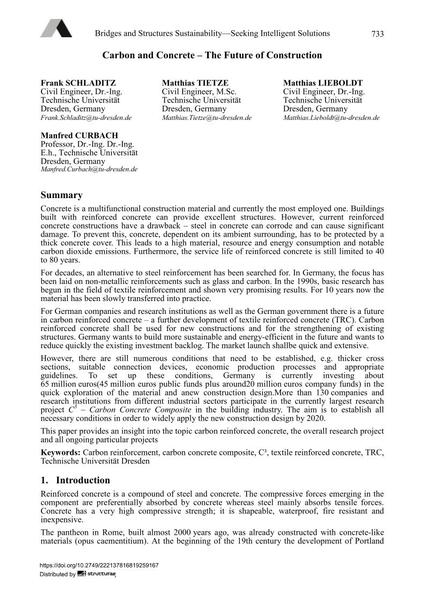Carbon and Concrete – The Future of Construction

|
|
|||||||||||
Bibliografische Angaben
| Autor(en): |
Frank Schladitz
Manfred Curbach Matthias Tietze Matthias Lieboldt |
||||
|---|---|---|---|---|---|
| Medium: | Tagungsbeitrag | ||||
| Sprache(n): | Englisch | ||||
| Tagung: | IABSE Conference: Bridges and Structures Sustainability - Seeking Intelligent Solutions, Guangzhou, China, 8-11 May 2016 | ||||
| Veröffentlicht in: | IABSE Conference, Guangzhou, China, 8 – 11 May 2016 | ||||
|
|||||
| Seite(n): | 733-743 | ||||
| Anzahl der Seiten (im PDF): | 11 | ||||
| Jahr: | 2016 | ||||
| DOI: | 10.2749/222137816819259167 | ||||
| Abstrakt: |
Concrete is a multifunctional construction material and currently the most employed one. Buildings built with reinforced concrete can provide excellent structures. However, current reinforced concrete constructions have a drawback – steel in concrete can corrode and can cause significant damage. To prevent this, concrete, dependent on its ambient surrounding, has to be protected by a thick concrete cover. This leads to a high material, resource and energy consumption and notable carbon dioxide emissions. Furthermore, the service life of reinforced concrete is still limited to 40 to 80 years. For decades, an alternative to steel reinforcement has been searched for. In Germany, the focus has been laid on non-metallic reinforcements such as glass and carbon. In the 1990s, basic research has begun in the field of textile reinforcement and shown very promising results. For 10 years now the material has been slowly transferred into practice. For German companies and research institutions as well as the German government there is a future in carbon reinforced concrete – a further development of textile reinforced concrete (TRC). Carbon reinforced concrete shall be used for new constructions and for the strengthening of existing structures. Germany wants to build more sustainable and energy-efficient in the future and wants to reduce quickly the existing investment backlog. The market launch shallbe quick and extensive. However, there are still numerous conditions that need to be established, e.g. thicker cross sections, suitable connection devices, economic production processes and appropriate guidelines. To set up these conditions, Germany is currently investing about 65 million euros(45 million euros public funds plus around20 million euros company funds) in the quick exploration of the material and anew construction design.More than 130 companies and research institutions from different industrial sectors participate in the currently largest research project C3 – Carbon Concrete Composite in the building industry. The aim is to establish all necessary conditions in order to widely apply the new construction design by 2020. This paper provides an insight into the topic carbon reinforced concrete, the overall research project and all ongoing particular projects |
||||
| Stichwörter: |
TRC
|
||||
